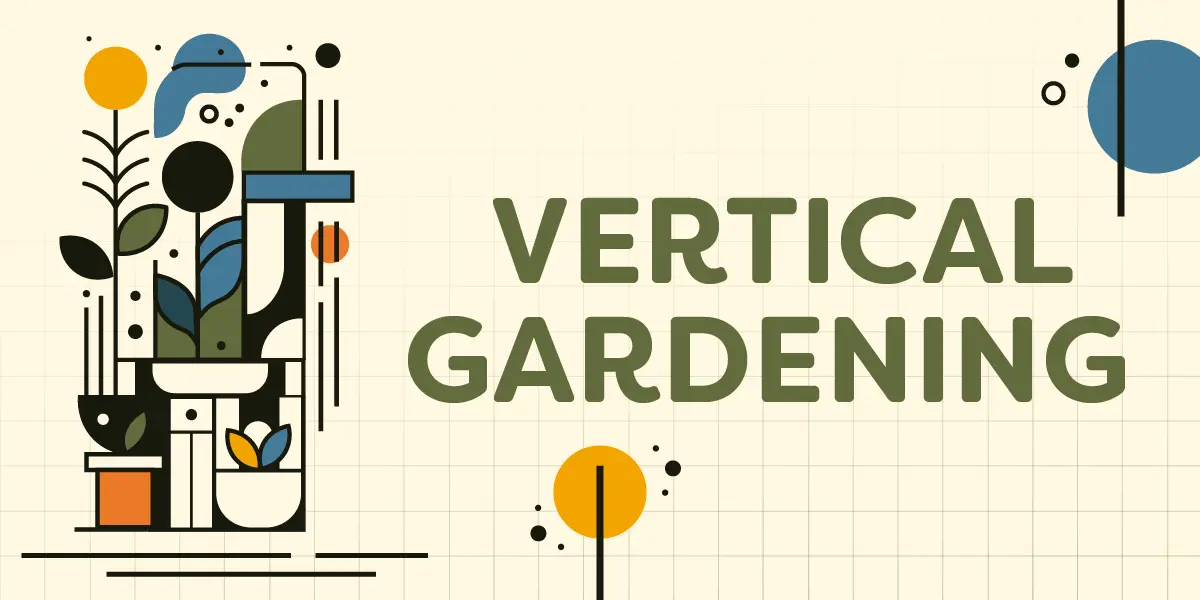If you can’t go wide, go high.
New York City was built on this concept; trees in dense forests follow the same principle.
Your tiny apartment balcony may lack the square footage for a lawn chair, but have you looked upwards recently? Chances are you have a good 10 feet of clearance — or more.
Enter vertical gardening, which lets you transform bare walls, tall corners, and view-blocking fences into verdant landscapes — or upscapes, as the case may be.
What Is Vertical Gardening?
Vertical gardening is the technique of growing plants upwards in tiers rather than outwards. It’s a perfect solution for urban dwellers, apartment owners, or anyone with limited ground space but an overwhelming desire to exercise their green thumb. It’s New York City versus Los Angeles, only for vegetation.
Even if you own more acreage than The Meadowlands, vertical gardening may be the best method to spruce up a porch or other space.
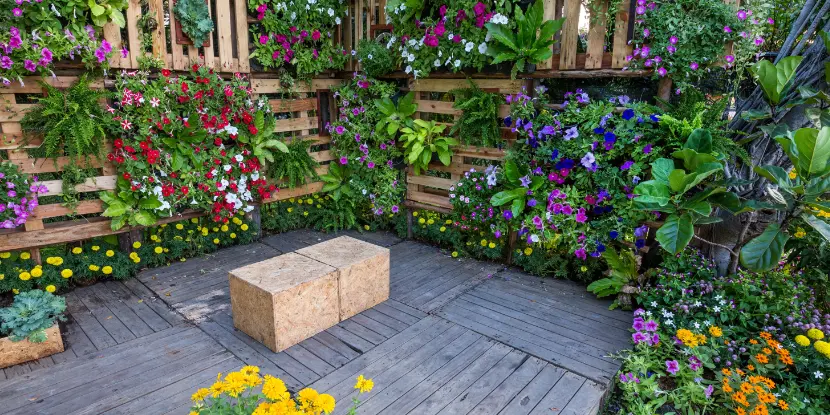
A deck enclosed by palette gardens.
Benefits of Vertical Gardening
Reasons to go vertical include:
- Efficient use of space: Vertical gardening makes the most of your limited area.
- Aesthetically pleasing: Vertical gardens can transform plain walls and fences into the Hanging Gardens of Babylon.
- Improved pest control: Elevated plants are out of reach of ground-dwelling pests. This elevation also allows for better air circulation, which reduces the odds of fungal infections and other plant diseases.
- Easy accessibility: Vertical gardening places plants at eye level, making them easier to tend to without bending or kneeling. This accessibility is a boon for gardeners with mobility issues or aching joints.
- Efficient watering: Many vertical gardens have built-in irrigation systems or cascading designs. Water trickles down from the top, reaching all plants with minimal waste.
- Enhanced privacy: A well-placed vertical garden can act as a natural privacy screen, dividing spaces or blocking unsightly views while offering the benefits of greenery.
- Better yield: Certain plants, like tomatoes, cucumbers, and beans, thrive when grown vertically and can produce higher yields due to improved sunlight exposure and air circulation.
- Urban gardening: For city dwellers, vertical gardening offers a way to cultivate fresh herbs, vegetables, or decorative plants, even in small apartments or condos.
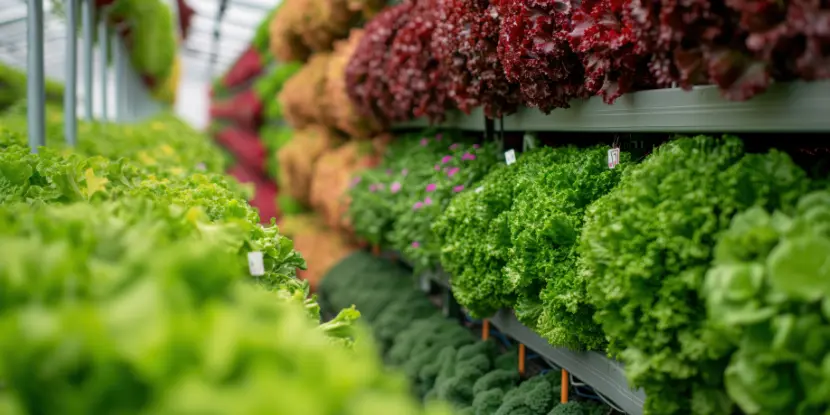
Tiered gardening in a commercial greenhouse.
Types of Vertical Gardens
Here, the options are many. Almost too many! It’s the paradox of choice! You’ll likely end up with one of the following configurations:
- Hanging gardens in pots or planters suspended from the ceiling or railing.
- Wall-mounted gardens using hanging pockets, fabric planters, or attached pallets.
- Tower gardens built with stacked containers or modular systems that enable vertical growth.
- Treillage (lattice) gardens, where vines are trained to grow on a framework against a wall or fence.
- Pallet gardens created by repurposing wooden pallets to hold plants in the open slats.
- Green walls or living walls that use hydroponic systems to grow plants on a vertical surface.
- Pocket gardens where plants grow out of pockets in a modular fabric or felt panel attached to a wall.
- Terraced gardens on slopes or inclines, using retaining walls to create tiers for planting.
- Indoor tower gardens with a hydroponic system that allows you to grow plants indoors, even without soil, using nutrient-rich water instead.
- Stacked pots or planters that let you create a vertical garden with your existing containers.
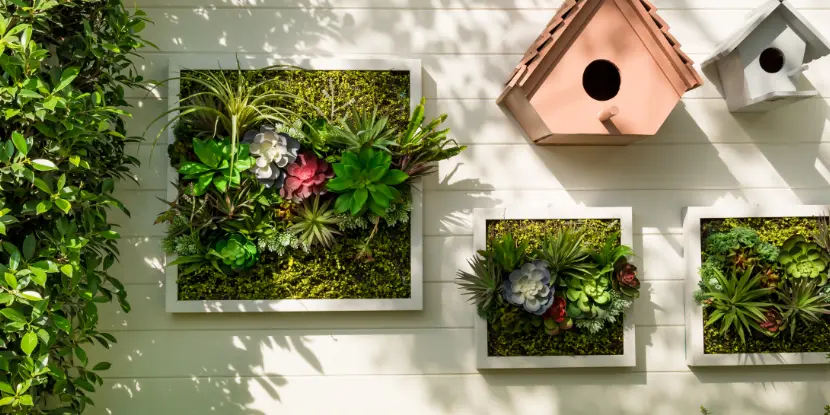
Frame gardens mounted on the side of a house.
Selecting Plants for Your Vertical Garden
The sunlight your space receives, the size and depth of your containers, and the climate in your area will determine the plants you can grow.
- Herbs: Basil, parsley, chives, mint, and other herbs do well in small containers and require little maintenance.
- Vegetables: Tomatoes, peppers, lettuce, kale, and other leafy greens thrive in vertical gardens with adequate sunlight and water.
- Flowers: From vibrant annuals to delicate perennials, many flowers grow like gangbusters in vertical gardens. Popular choices include petunias, pansies, geraniums, and impatiens.
- Vines: Plants like grapes, hops, and climbing roses are perfect for trellis or lattice-style vertical gardens.
- Succulents: Low-maintenance succulents, like cacti and aloe vera, are excellent options for small vertical gardens.
Best Vertical Gardens for DIY Enthusiasts
The following vertical gardens are easy and fun to build:
1. Hanging Planters
These planters can hold herbs, flowers, or small vegetables. Almost any container, from mason jars to recycled plastic bottles, will work.
How to Build
- Find a sturdy and lightweight container.
- Drill holes in the bottom of the container for drainage.
- Fill the container with potting soil, leaving some space at the top for watering.
- Add your plants to each planter.
- Hang the planters from hooks attached to a wooden frame or wall. For visual interest, hang them at varying heights.
2. Vertical Pallet Garden
Wooden pallets can be upcycled into vertical gardens for small herbs, flowers, and succulents.
How to Build
- Find a clean, sturdy pallet and sand it to remove rough edges.
- Staple landscape fabric or burlap to the back and sides of the pallet to keep soil in place.
- Fill the pallet with soil and plant your greenery in the slats.
- Prop the pallet against a wall or mount it securely.
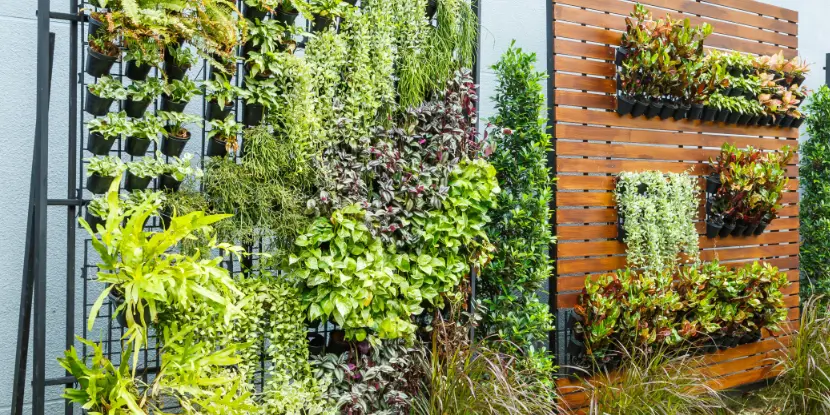
A metal-frame vertical and palette garden side-by-side.
3. Trellis Garden
A trellis garden is ideal for vining plants like tomatoes, cucumbers, and beans.
How to Build
- Purchase or build a sturdy trellis from wood or metal.
- Install the trellis in a garden bed, large pot, or along a fence.
- Set vining plants at the base and secure them with soft ties to train them upward.
4. Wall-Mounted Planter Boxes
Vertical planter boxes attached to a wall can create a stunning green feature.
How to Build
- Build or buy wooden or metal planter boxes in the sizes that fit your needs.
- Use brackets or hooks to mount the boxes to an exterior or interior wall securely.
- Fill the boxes with potting soil and plant your greenery.
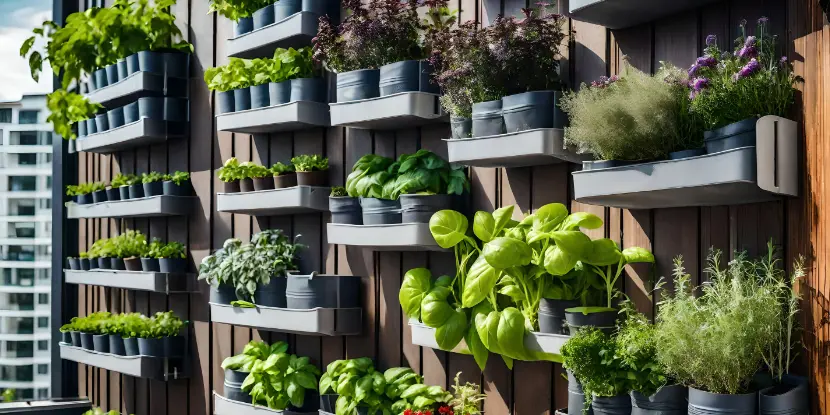
A tiered garden on a high fence.
5. Gutters as Planters
Rain gutters can be repurposed into a tiered vertical garden for shallow-rooted plants like lettuce, strawberries, and herbs.
How to Build
- Cut the gutters to your desired length and drill drainage holes at regular intervals.
- Attach end caps to the gutters.
- Use strong brackets to mount the gutters to a wall or frame.
- Fill the gutters with potting soil and plant your greenery.
6. Pocket Garden
Fabric pocket gardens can be hung on walls and are perfect for growing herbs, flowers, and small lettuces. These modular systems are easy to install and maintain.
How to Build
- Purchase a modular fabric pocket garden or create your own out of felt or other sturdy fabric.
- Attach the pocket system to a wall with screws or hooks.
- Fill the pockets with potting soil and plant your greenery.
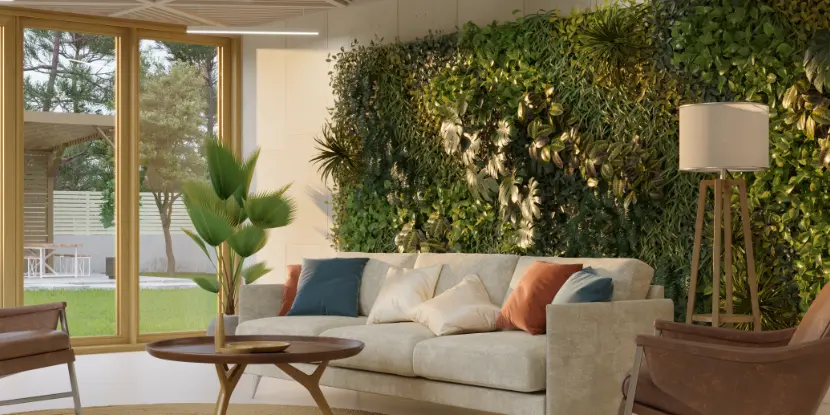
A vertical garden is a design element in a modern living room.
Hydroponic Vertical Garden Kits
Hydroponic vertical gardens offer several advantages:
- Higher yield: Hydroponic systems often produce better crops because plants have access to a continuous nutrient supply.
- Water conservation: Hydroponic gardens use significantly less water than soil gardens due to their recirculating systems.
- Faster growth: Plants in hydroponic systems typically grow faster due to optimized nutrient delivery.
- Limited weeds and pests: Vertical and hydroponic setups reduce the likelihood of weeds and soil-borne pests.
- Customization and scalability: These kits can be tailored to fit any space or scale, from small kitchen gardens to larger installations.
- Healthier plants: Controlled hydroponic systems eliminate soil-related diseases, producing healthier plants and produce.
- Year-round growing: Vertical hydroponic gardens enable year-round cultivation regardless of the season, especially in indoor setups.
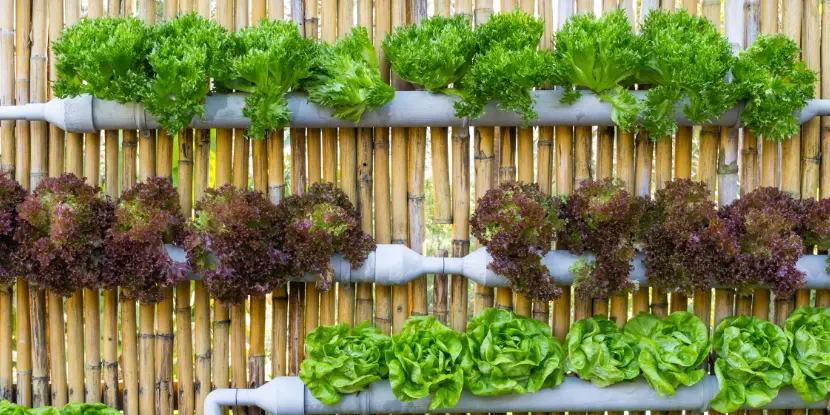
A hydroponic garden mounted on a bamboo fence.
Tips for Vertical Gardening Success
But what about light, you ask? Fertilizer and pests?
We’re getting there. Vertical gardens are relatively low-maintenance, but follow these tips for the best chance of success:
- Light: Choose plants that match your light conditions. If you have a small window and little natural light, select herbs like basil or thyme, which don’t need as much sun, or purchase full-spectrum grow lights to supplement the weak natural light.
- Soil: Use a high-quality potting mix that drains well.
- Watering: Since vertical gardens require more frequent watering (but less total water) than traditional gardens, consider investing in an automated irrigation system or self-watering containers to make your life easier.
- Fertilizing: Apply a balanced liquid fertilizer every few weeks.
- Pests: Monitor your plants regularly and treat any pest issues immediately. Organic controls include insecticidal soap or neem oil.
- Maintenance: Keep your vertical garden clean and tidy. Remove dead or dying plants and prune regularly to maintain your garden’s desired shape and size.
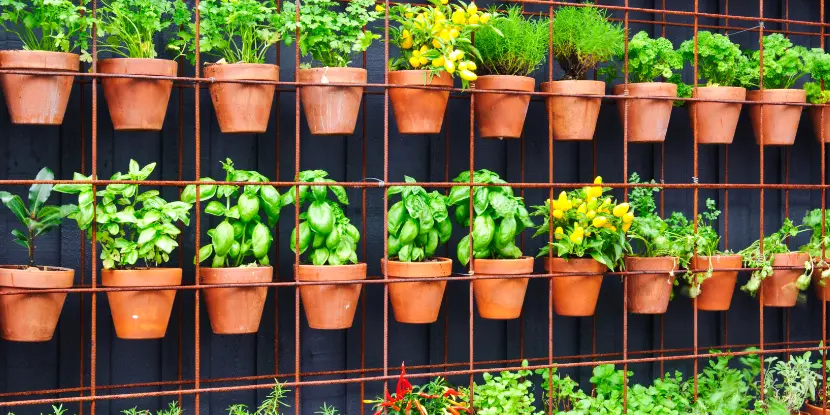
A simple vertical garden with ports mounted on a metal frame.
Ideas & Inspiration
Now that you have the basics, it’s time to get creative! Here are a few ideas to start you on your vertical journey:
Repurposed Shoe Organizer Garden
Hang an old shoe organizer on a wall or fence to transform it into a vertical garden. Each pocket can accommodate a different herb, flower, or small vegetable. This approach highlights sustainability and makes excellent use of small spaces.
Frame Garden
Attach a wire mesh to the back of an old picture or window frame, then fill the gaps with moss and soil. Insert succulents or small flowers into the mesh for an eye-catching framed garden.
Vertical Herb Spiral
Create a winding, vertical structure out of stones or bricks. This layered design increases planting area and amplifies visual interest. Herbs thrive in this environment, benefiting from the varied sunlight exposure based on their placement in the spiral.
Gutter Garden Wall
Mount repurposed rain horizontally on a wall or fence. This simple yet unusual idea is perfect for growing shallow-rooted plants like strawberries, lettuce, and herbs. The staggered configuration allows water to trickle from one gutter to the next, optimizing water use.
Paint Can Planters
Collect and reuse old paint cans as bold, industrial-style planters. Mount them directly to a wall or on a wooden board in a vertical display.
Stacked Wooden Crates
Stack wooden crates or boxes to build a modular, multi-level vertical garden. Each crate can hold different plants, and the open design facilitates excellent drainage and air circulation.
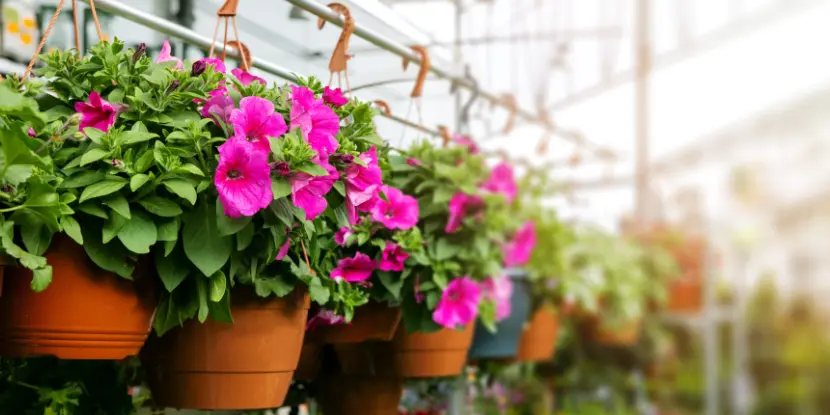
Hanging pots of flowers in a greenhouse.
FAQs: Creating a Vertical Garden
Q: Can I keep a vertical garden indoors?
Vertical gardens can thrive indoors with proper lighting and maintenance. Consider using grow lights or placing your garden near a sunny window.
Q: How can I prevent water damage from my indoor vertical garden?
Place a waterproof barrier behind your vertical garden or a tray underneath to collect excess water. Use well-draining soil and avoid overwatering.
Q: What types of plants are best for vertical gardens?
Plants with shallow roots, such as herbs, succulents, and small vegetables, are ideal for vertical gardens. Before selecting a plant, consider its light and space requirements.
Q: Do I need to fertilize my vertical garden?
Yes. Fertilize your vertical garden every few weeks with a balanced liquid fertilizer to promote healthy growth and maximize yield.
Q: Can I grow vegetables in a vertical garden?
Tomatoes, peppers, lettuce, and many other vegetables can flourish in vertical gardens with adequate sunlight and climbing support.
Q: Are vertical gardens difficult to maintain?
Due to their compact size and accessibility, they can be easier to manage. With proper planning and care, maintenance can be minimal.
Q: Can I build my own vertical garden structure?
Numerous DIY vertical garden ideas and tutorials are available online, ranging from simple pallet planters to intricate living wall systems. Just ensure your structure is sturdy enough to support your chosen plants.
Q: What support do climbing plants need in a vertical garden?
Climbing plants like peas, beans, and tomatoes benefit from trellises, stakes, or netting to support and encourage upward growth. Ensure the support structures are sturdy and appropriately anchored to handle the weight of mature plants.
Q: How can I improve air circulation in my vertical garden?
Space plants adequately within each tier, avoid overcrowding, and regularly prune excess foliage. Open-design planters, like wire baskets or crates, can also help airflow, which is crucial for plant health.
Q: Can vertical gardens help insulate a home?
Yes, they act as natural insulators. When installed on external walls, they provide a layer of thermal insulation, reducing heat absorption in the summer and heat loss in the winter. This contributes to energy savings and a more comfortable indoor environment.

